There are a ton of blanket options on the market. And with so many different types, it can be easy to feel overwhelmed. Luckily, I have all the information you need to know before buying a new blanket for your home.
Read on below to learn more about some common types of blankets and blanket materials. Then I’ll help you decide which type of blanket might be best for you.
Types of Blankets Explained
Here are 10 types of blankets on the market for you to consider. Let’s go over each one and explain how they differ from one another.
Comforter
A comforter is a thick, plush blanket often used year-round on beds. Comforters are made of two large fabrics sewed together and are filled with materials ranging from warming down to lightweight cotton. The amount of fill will determine how lofty the comforter is, but not necessarily how warm it will be. Depending on the materials your comforter is made with, it can either feel heavy and cozy or breathable and moisture-wicking.
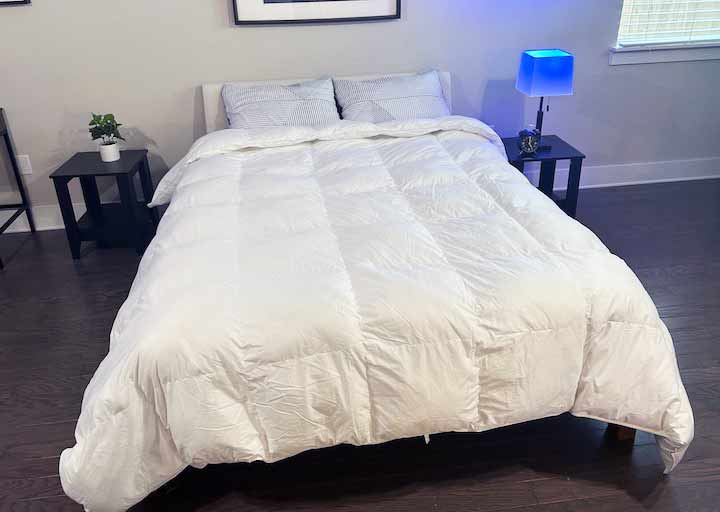
Comforters come in a wide variety of patterns and colors, so they’re great options for sleepers looking to spruce up their bedrooms. Similarly, comforters will range in price. Luxury comforters can be made from fabrics with a higher thread count like Egyptian cotton or silk, and have down filling—these types can almost never be machine-washed. While budget comforters may be less lofty than luxury comforters, they are likely machine-washable and dryer-safe. All in all, comforters are great for almost any sleeper. Check out our best comforters 2024 article if you’re interested in checking some out.
Duvet
Duvets are similar to comforters and may also be filled with down, cotton, wool or synthetic batting. But unlike comforters, duvets are meant to be inserted into interchangeable duvet covers. The biggest difference between a comforter and a duvet insert is that the duvet insert isn’t sewn through like a comforter is.
A duvet cover is undoubtedly easier to clean than a comforter since they are removable and often machine-washable. Duvet covers are also cheaper than comforters, so you can swap out bedding whenever you’d like to give your bedroom a makeover. Many comforters double as duvet inserts these days, too.
Some duvets sleep warmer than a light- to medium-weight comforter, and heavier duvets are great for people who live in cold climates. But like comforters, duvets and duvet covers can be made with a variety of materials, some of which are better for hot sleepers, like bamboo or TENCEL. One downside of a duvet is that sometimes the filling can bunch up inside its cover and be hard to redistribute. So look for duvet inserts and covers with ties or fasteners to prevent shifting or bunching.
Quilt
Quilts are made of a top layer, batting and a bottom layer. Quilts’ top layers are often designed in a patchwork style and may incorporate sentimental fabric or meaningful patterns. Quilt batting goes in between the two layers of fabric to add warmth and is usually made of wool, down or polyester.
Quilts are more lightweight and lay flatter than comforters or duvets. Their breathability makes them a nice option for the summer months, but a wool-filled quilt can still do a good job keeping you warm in the winter. They are perfect for those wanting a rustic look with lots of color and intricate patterns.
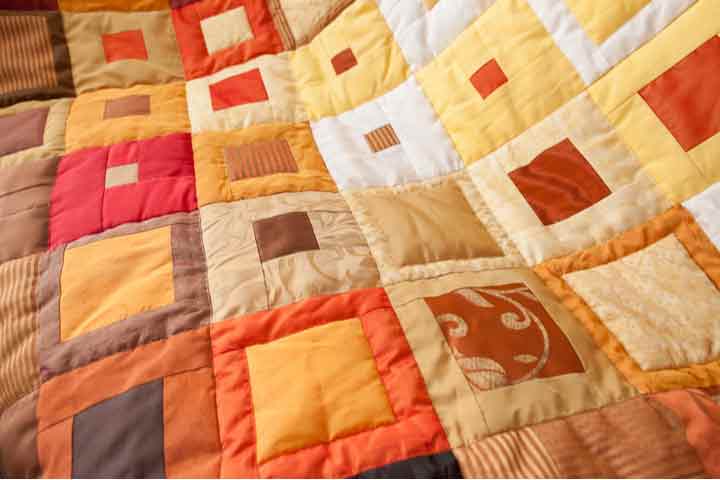
RELATED: Quilt vs Comforter – Which is Better?
Throw Blanket
Throw blankets are smaller than a comforter or duvet and are not meant to cover an entire mattress. These blankets are often used for decoration, and add a touch of comfort and warmth rather than serving as your main blanket to sleep with. Throw blankets are lightweight and come in a variety of fabrics and patterns to provide color and texture to your bedroom or living room.
The most popular throw blanket materials are ones that are lightweight while insulating, and easy to maintain. Fleece, cotton and microfiber all make for good throw blanket materials. If you are looking for the perfect multi-use blanket for lounging on the couch or adding a slight touch of warmth at night, then a throw blanket is what you want.
Waffle Weave Blanket
Waffle weave blankets have a stylish look that stands out among other blankets, typically made from cotton woven in a square pattern resembling a waffle. They’re great options for summer months if you use them alone, and can be easily layered under thicker blankets or down comforters when it gets cold.
The weave is meant to regulate body heat, so they’re a nice layering fabric year-round. Waffle weave blankets are considered low-maintenance because they are machine-washable and dryer-safe.
Weighted Blanket
Weighted blankets are great options for anyone who wants to feel swaddled or hugged while sleeping. They are designed to provide users with a calming sensation known as deep touch pressure. Gentle pressure from a weighted blanket or a hug calms the nervous system, which can make it easier to fall asleep and stay asleep. As a rule of thumb, select a weighted blanket that is around 10% of your body weight to feel the benefits of deep touch pressure.
Most weighted blankets get their weight from filling materials like glass beads or plastic pellets. A weighted blanket’s outer cover keeps its weight evenly distributed, sometimes in a quilted pattern. Weighted blankets tend to sleep hotter than a comforter or duvet because of their heavier mass. If you are a hot sleeper, look for a weighted blanket with a cooling, moisture-wicking cover to prevent overheating.
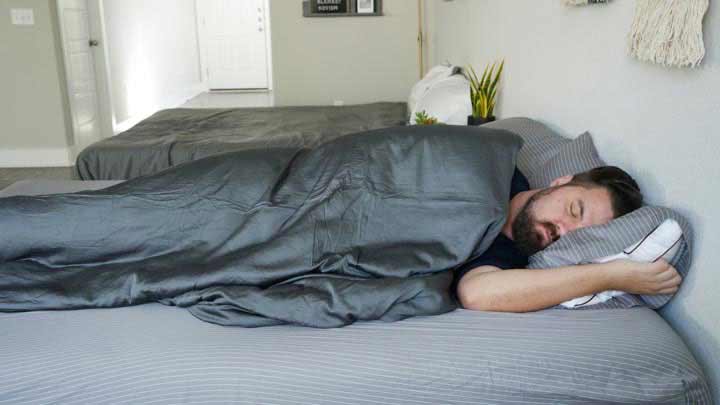
RELATED: Weighted Blanket Pros and Cons
Heated Blanket
During the coldest months of the year, a heated blanket can feel more comfortable than layering blankets and bedding. Heated blankets generate their heat from electricity and have outer layers made from lightweight yet insulating materials like fleece or microfiber. Underneath the outer cover is a layer of insulated wires that will heat up when turned on. These blankets plug into an outlet and you can often choose from about three heat settings (low, medium and high).
These warm blankets are great options for people who live in especially cold climates and are also nice heating pad alternatives if you suffer from pain or cramps. Keep in mind that while these blankets are not flammable, leaving them on all night is a fire hazard. I recommend choosing a heating blanket with a timer or automatic shut-off feature to prevent overheating or injury.
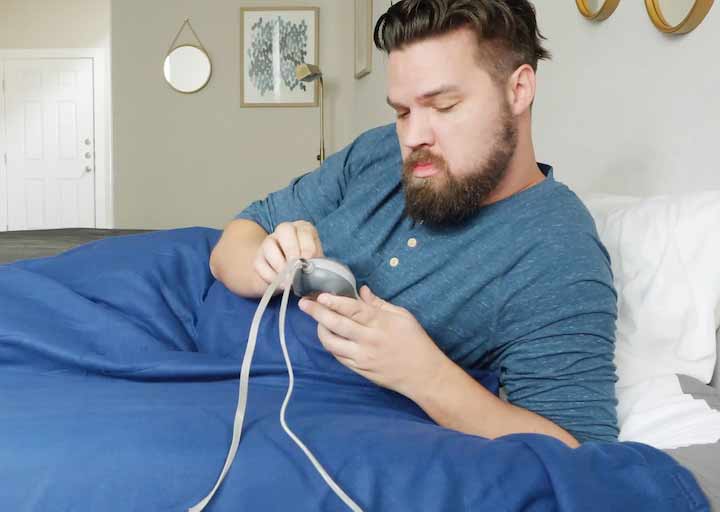
Sherpa Blanket
Sherpa is made from either cotton or polyester and is meant to mimic the look and texture of sheep wool. Sherpa blankets often have one side made from fuzzy, textured sherpa and one side made from a soft, plush material like fleece. These blankets vary in weight and are also incredibly warm. Sherpa throws are also very popular, and a great option for keeping on the couch.
Sherpa blankets are also quite affordable, but they are not as durable as other blankets. In order to preserve a sherpa’s blanket softness, wash it in cold water and use low heat in the dryer. But always consult a blanket’s care tag for how to safely wash it.
RELATED: How to Wash a Sherpa Blanket
Coverlet
Coverlets are mainly used for decorative purposes to be paired with other blankets.They are made with lightweight layers that can be used like blankets between your sheet and duvet or be thrown on top of your other bedding to add decoration. Coverlets should be just large enough to have a slight amount of overhang over the edge of your mattress.
They are perfect for hot sleepers who overheat with a comforter or duvet in the summer. They’re normally made of lightweight fabrics like cotton, linen or silk and are often embroidered with colorful designs so they’re great for achieving that layered look. Because coverlets come in a variety of materials and designs, there are options for everyone.
Afghan
Afghans are colorful knit or crochet blankets made from yarn. They are cozy and warm, but fairly lightweight because they’re only a single layer of fabric. Afghans come in a wide variety of designs and sizes because they are commonly made by hand.
Depending on the yarn that is used, afghans can have slightly different textures. Because of their delicate construction, afghans must be hand-washed or dry-cleaned only. They are not as easy to maintain as similar throw blankets or coverlets.
Different Blanket Materials
Blankets come in different sizes,styles and in a variety of fabrics. Take a look below for a quick breakdown of a few of the most popular blanket materials.
Cotton
Cotton is an all-natural fiber used in most duvets, duvet covers, comforters and quilts. It’s easy to care for, breathable and an overall popular choice for bedding. The texture of a cotton blanket will depend on its weave style, but most cotton blankets are known for having a soft and crisp feel.
Down
Down is the group of fine feathers found underneath birds’ tough exterior feathers. It is often sourced from duck, goose or swan feathers and used as a filling in pillows and comforters. Down is a great insulator and feels lightweight and soft. There are also plenty of down alternative options made with synthetic materials for sleepers concerned about allergies, price or ethical sourcing.
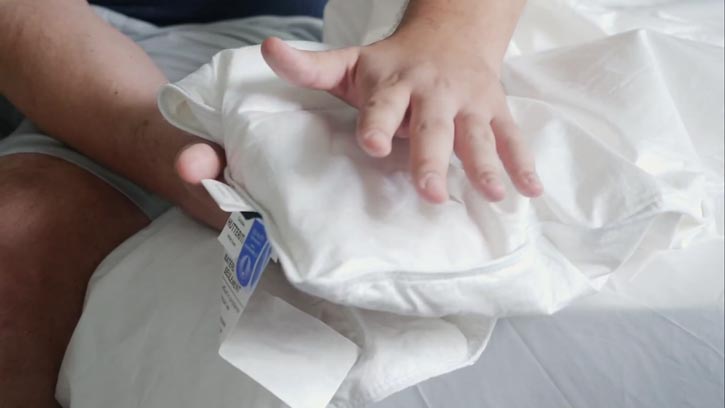
Vellux
Vellux is a fabric that is made by layering polyurethane foam between thin adhesive pieces of fabric. Then nylon fibers are attached to this adhesive, creating a soft and pliable texture. The result is a blanket that is lightweight, insulating and long-lasting. Vellux blankets are ideal for people with allergies because their construction won’t trap dust or other particles.
Microfiber
Microfiber is a synthetic fabric made from fine polyester strands and has a soft and plush feel. It’s also very warm and usually budget-friendly. Microfiber is one of the most popular bedding fabrics because of its affordability and durability. Comparatively, microfiber is more absorbent and breathable than fleece, which has many similarities to microfiber.
Polyester
Polyester is another synthetic fabric, and it is one of the most popular synthetic bedding fabrics. It is also common to find polyester-blend comforters or duvets, as well as to find polyester in things like throws and coverlets. This fabric is easy to care for and affordable. Polyester tends to trap heat and is not as breathable, so hot sleepers should opt for a different blanket material.
Fleece
Fleece is a synthetic insulating fabric made of polyester fibers. It’s super warm and insulating and a great pick for warm throw blankets. It’s also a very common outer layer in heated blankets. If you’re looking for a blanket that is warming yet lightweight, definitely consider fleece.
Wool
Wool is a natural fiber produced by various animals including sheep and goats. It’s naturally moisture wicking and temperature regulating, making it a great option in all seasons. Most wool blankets tend to feel heavy and cozy, but they can also be lightweight. Wool may feel a little scratchy to some sleepers, so you may want to use wool blankets with a top sheet or coverlet to avoid irritating your skin.
Choosing the Right Blanket
As you can see, there are many different types of blankets to consider when looking for new bedding. To make the process of buying a blanket easier, here are four things you should keep in mind.
Season
The climate where you live and the time of year will determine how warm your bedding should be. Not all blankets will feel comfortable to use year-round. A blanket that keeps you extra warm in the winter will likely be too hot to sleep with in the summer.
Opt for heavier blankets made from warm materials like wool in colder seasons and lightweight blankets and blankets made from breathable, cooling fabrics when it’s warmer. As temperatures drop in the fall and winter, you can also add lightweight layers to a duvet or comforter for additional coziness.
Material Preferences
Different blanket materials serve different purposes for sleepers. Fabrics could be lightweight or heavy, warm or cooling or crisp or plush. The material your blanket is made of will determine how easy or difficult it is to clean and maintain. There is no best material for a blanket to be made of, so whatever is most comfortable for you all night should be the material you choose.
Allergies and Sensitivities
If you are prone to allergies, there are anti-allergy bedding options specifically designed to not worsen allergies. Anti-allergy blankets are made with tightly woven fabrics which don’t collect allergens between the blanket’s fibers. The best materials for people with allergies include wool, silk, bamboo and cotton. These materials shouldn’t trap or attract allergens in your sleep environment. Also look for certified organic fabrics made without harmful chemicals if you are allergy-prone.
Budget
Blankets come at a variety of price-points from less than $10 to hundreds of dollars. More affordable blankets will likely have a simpler design and be made with more inexpensive materials. On the lower end, throw blankets will be more inexpensive because they are lightweight, meant to be for one person and are often made from synthetic materials. Blankets like duvets and weighted blankets that have a more intricate construction are higher-end. Also, the larger the mattress you are buying your blanket for, the more expensive it will be.
FAQs
What is the warmest type of blanket?
Down comforters or down-filled duvets are the warmest blankets besides electric heated blankets. These are great options for colder climates and very popular in the winter months because down tends to be a natural insulator. And down comforters and duvets can have fluffy, lofty fills which are perfect at retaining heat.
What is the difference between a throw and a blanket?
A throw is a type of blanket that is large enough for one person to sleep or lounge with. They are commonly made from one piece of lightweight, warm fabric like fleece or microfiber. There are many types of blankets that vary in size and weight which have varying purposes. Blankets like duvets and comforters are better for sharing and are designed to be the main blanket someone sleeps with, unlike a throw blanket.
What is the best type of blanket for summer?
Lightweight quilts or cooling duvets are some of the best blankets for the summer months. Thinner blankets like throw blankets or coverlets usually meant for layering can also be used on their own if you are a hot sleeper.
What type of blanket is the softest?
Sherpa blankets are very soft and are meant to mimic fluffy sheep’s wool. Another blanket material that is especially soft and plush is minky, which is a common cover for weighted and heated blankets.

